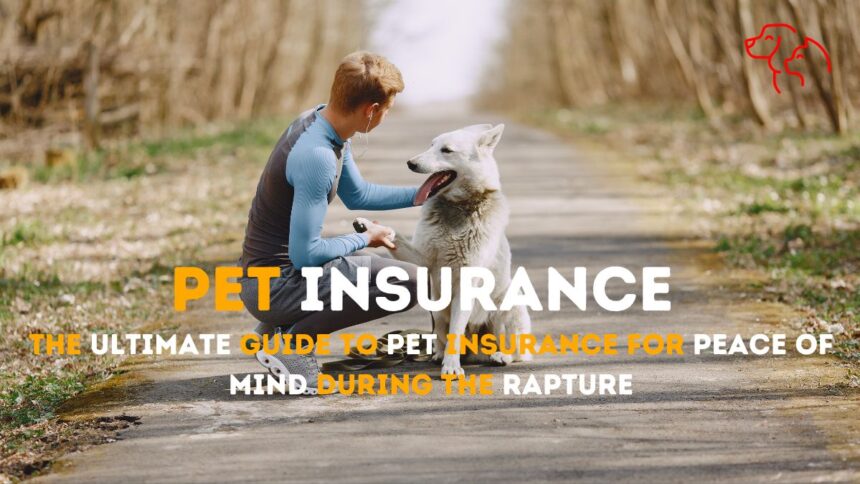Introduction
Are you prepared for the apocalypse? While most people might focus on surviving the end of the world, have you considered the well-being of your furry companions? As a responsible pet owner, it’s essential to plan for their safety too. That’s where pet insurance comes in to save the day – even if it’s the day of the rapture.
In this ultimate guide to pet insurance, we’ll explore how you can protect your beloved pets during the most chaotic times. Whether it’s a natural disaster, global pandemic, or post-apocalyptic event, having pet insurance offers the peace of mind you need.
From covering veterinary costs in the aftermath of destruction to providing emergency accommodation for your pets, pet insurance plays a vital role in ensuring their safety. So why leave their fate to chance when you could have a reliable insurance policy in place?
Discover the various pet insurance options available for all types of pets, learn how to choose the right one for your furry friends, and understand the benefits of having this safety net when the world turns upside down. Get ready for the rapture with pet insurance on your side!
Why pet insurance is important
In times of crisis, whether it’s a natural disaster, global pandemic, or the impending rapture, the well-being of our beloved pets should be a top priority. Pet insurance can be the difference between your furry friend receiving the care they need or being left vulnerable during the most chaotic situations.
When disaster strikes, the last thing you want to worry about is how you’ll afford the veterinary bills for your pet. Unforeseen medical emergencies can be financially devastating, especially in the aftermath of a catastrophic event. Pet insurance provides a safety net, ensuring that your pet can receive the necessary treatment without putting a significant strain on your finances.
Moreover, during a crisis, access to veterinary services may be limited or disrupted. Pet insurance can help you secure emergency accommodation for your pets, ensuring they have a safe place to stay if you need to evacuate or seek shelter. This gives you the peace of mind knowing that your furry companions are cared for, even when the world around you is in turmoil.
Types of pet insurance coverage
When it comes to pet insurance, there are several types of coverage to consider. Comprehensive plans typically offer the most extensive protection, covering a wide range of medical expenses, including accidents, illnesses, and routine care. These plans can be particularly valuable in the event of a crisis, as they can help alleviate the financial burden of unexpected medical emergencies.
Accident-only plans, on the other hand, provide coverage specifically for injuries sustained through accidental means, such as a car accident or fall. While these plans may be more affordable, they may not provide the level of protection needed during a widespread disaster or the rapture.
Wellness plans are designed to cover the cost of preventive care, such as annual check-ups, vaccinations, and routine dental cleanings. While these plans may not be as crucial during a crisis, they can help ensure your pet’s overall health and well-being, which can be especially important in times of stress and uncertainty.
It’s important to carefully review the coverage details of each pet insurance plan to ensure that it meets your specific needs and the potential challenges you may face during a catastrophic event. By understanding the different types of coverage available, you can make an informed decision and choose the plan that best protects your furry companion.
How to choose the right pet insurance plan
When selecting a pet insurance plan, there are several factors to consider to ensure you choose the right coverage for your beloved pet.
First and foremost, consider the type of coverage you need. As mentioned earlier, comprehensive plans offer the most extensive protection, but they may also come with a higher premium. Evaluate your pet’s age, breed, and health history to determine the level of coverage that best suits their needs.
Next, look at the deductible and co-payment requirements. A higher deductible can lower your monthly premiums, but it may also mean you’ll need to pay more out-of-pocket before the insurance coverage kicks in. Similarly, co-payment percentages can vary, so be sure to understand how much you’ll be responsible for when it comes to your pet’s medical expenses.
It’s also important to consider the annual and lifetime coverage limits. Some plans may have a maximum amount they will pay out per year or over the lifetime of your pet. This can be especially crucial during a crisis when veterinary costs may be higher due to increased demand and limited resources.
Additionally, review the waiting periods and exclusions for pre-existing conditions. Many pet insurance plans have a waiting period before certain coverage takes effect, and they may not cover pre-existing medical issues. Understand these limitations to ensure your pet is fully protected when you need it most.
By carefully evaluating these factors, you can find the pet insurance plan that provides the best coverage for your furry friend, giving you the peace of mind you need during the rapture or any other catastrophic event.

Factors to consider when comparing pet insurance providers
When it comes to choosing a pet insurance provider, it’s essential to do your research and compare multiple options. Not all pet insurance companies are created equal, and the level of coverage, customer service, and claims processing can vary significantly.
One crucial factor to consider is the financial stability and reputation of the insurance provider. Look for companies with a strong financial rating and a track record of paying claims promptly and fairly. During a crisis, you’ll want to be confident that your provider will be able to fulfill their obligations and support you and your pet.
Another important aspect to evaluate is the network of veterinary providers. Some pet insurance plans may have a limited network, which could restrict your ability to choose the best care for your pet. Opt for a provider that offers a wide network of veterinary professionals, ensuring you have access to quality care no matter where you are during a crisis.
Customer service should also be a top priority. Look for pet insurance companies that are known for their responsive and helpful customer service, as you may need to rely on them heavily during a disaster or the rapture. Read online reviews and testimonials to get a sense of the level of support you can expect from your provider.
Finally, consider the claims process and how easy it is to file and receive reimbursement. In times of crisis, the last thing you want to worry about is navigating a complex and time-consuming claims process. Choose a provider that offers a streamlined and user-friendly claims experience, allowing you to focus on the well-being of your pet.
By carefully evaluating these factors, you can find a pet insurance provider that will be there for you and your furry companion when you need them the most, even in the face of the apocalypse.
Frequently asked questions about pet insurance
Q: Does pet insurance cover pre-existing conditions?
A: Most pet insurance plans do not cover pre-existing conditions, which are medical issues that your pet had before the policy was purchased. However, some providers may offer coverage for certain pre-existing conditions if they have been successfully treated and your pet has been symptom-free for a specified period of time. It’s important to review the policy details carefully to understand the limitations around pre-existing conditions.
Q: What types of pets can be covered by pet insurance?
A: Pet insurance is typically available for a wide range of pets, including dogs, cats, birds, rabbits, and even exotic animals like reptiles and small mammals. The coverage and premiums may vary depending on the type of pet, so it’s essential to research the options available for your specific furry (or scaly) friend.
Q: How much does pet insurance cost?
A: The cost of pet insurance can vary greatly depending on factors such as the type of coverage, your pet’s age and breed, and the deductible and co-payment requirements. On average, pet insurance premiums can range from $20 to $100 per month, with more comprehensive plans typically costing more. It’s important to get quotes from multiple providers to find the most affordable option that still provides the level of coverage you need.
Q: Does pet insurance cover routine care and preventive treatments?
A: While some pet insurance plans offer wellness coverage for routine care, such as annual check-ups, vaccinations, and dental cleanings, others do not. If you want your pet insurance to cover these types of preventive treatments, be sure to look for a plan that specifically includes a wellness or preventive care component.
Q: Can I cancel my pet insurance policy at any time?
A: Yes, most pet insurance providers allow you to cancel your policy at any time. However, it’s important to review the terms and conditions of your specific plan, as some may have cancellation fees or require a minimum enrollment period before you can cancel without penalty. If you’re considering canceling your policy, make sure to do so in a timely manner to avoid any unexpected charges.
Tips for saving money on pet insurance
Protecting your pet with insurance doesn’t have to break the bank. Here are some tips to help you save money on your pet insurance premiums:
- Shop around: Compare quotes from multiple pet insurance providers to find the best deal. Premiums can vary significantly, so it’s worth taking the time to explore your options.
- Consider a higher deductible: Opting for a higher deductible can lower your monthly premiums, but make sure the deductible amount is still manageable for your budget.
- Explore discounts: Many pet insurance providers offer discounts for things like insuring multiple pets, paying annually instead of monthly, or enrolling in automatic payments.
- Choose the right coverage: Evaluate your pet’s needs and select a plan that provides the necessary coverage without paying for unnecessary extras.
- Start coverage early: Enrolling your pet in a pet insurance plan when they are young can help keep premiums lower over the long run.
- Maintain your pet’s health: Taking good care of your pet’s health through preventive care can help reduce the likelihood of costly medical issues and potentially lower your insurance premiums.
- Review your policy annually: As your pet ages, their insurance needs may change. Review your policy each year to ensure you’re still getting the best value.

By implementing these money-saving strategies, you can ensure your furry friend is protected without breaking the bank, even in the face of the rapture or other catastrophic events.
Common misconceptions about pet insurance
- Pet insurance is too expensive: While pet insurance can seem costly, the potential savings in the event of a medical emergency or crisis can far outweigh the monthly premiums. When you consider the high cost of veterinary care, especially during a disaster, pet insurance can be a wise investment.
- Pet insurance doesn’t cover pre-existing conditions: While it’s true that most pet insurance plans do not cover pre-existing conditions, some providers may offer coverage for certain pre-existing issues if they have been successfully treated and your pet has been symptom-free for a specified period.
- Pet insurance is only for emergencies: Many pet insurance plans offer coverage for routine and preventive care, such as annual check-ups, vaccinations, and dental cleanings. This can help maintain your pet’s overall health and well-being, which can be especially important during times of crisis.
- Pet insurance is a waste of money: Pet insurance can provide invaluable peace of mind and financial protection, especially in the event of a disaster or the rapture. By covering the cost of veterinary care, pet insurance can help ensure your furry friend receives the treatment they need, without draining your savings.
- Pet insurance is difficult to use: While the claims process may vary between providers, many pet insurance companies have streamlined their procedures to make it easier for pet owners to file and receive reimbursement. By understanding the claims process and requirements, you can ensure a smooth experience when you need to use your pet’s insurance coverage.
Addressing these common misconceptions can help pet owners recognize the true value of pet insurance and its importance in safeguarding their beloved companions during the most challenging times.
Steps to take when filing a pet insurance claim
In the aftermath of a crisis or the rapture, the last thing you want to worry about is navigating a complex claims process for your pet’s insurance. By understanding the steps involved, you can ensure a smooth and efficient experience when it’s time to seek reimbursement for your pet’s medical expenses.
- Review your policy: Familiarize yourself with the coverage details, deductibles, and any specific requirements for filing a claim. This will help you gather the necessary information and documentation.
- Gather the required documentation: Typical documentation needed for a pet insurance claim includes your veterinary bills, a detailed description of the medical issue or treatment, and any supporting documentation, such as diagnostic test results or a veterinary prescription.
- File the claim promptly: Most pet insurance providers have specific timelines for submitting claims, so be sure to file your claim as soon as possible to ensure it is processed in a timely manner.
- Submit the claim: Follow the provider’s instructions for submitting the claim, which may involve uploading documents through an online portal, sending them by mail, or even faxing the information.
- Track the claim status: Once you’ve submitted the claim, keep an eye on its progress. Many pet insurance providers offer online portals or customer service representatives who can provide updates on the status of your claim.
- Respond to any requests for additional information: Your insurance provider may require additional documentation or clarification to process your claim. Be sure to respond promptly to avoid delays.
- Receive reimbursement: Once your claim is approved, your pet insurance provider will issue the reimbursement, either directly to you or to the veterinary clinic, depending on the terms of your policy.
By following these steps and staying organized throughout the claims process, you can ensure that your pet receives the necessary care during a crisis or the rapture, without the added stress of financial concerns.
Conclusion: The importance of pet insurance for peace of mind during the rapture
As the world faces the uncertainty of the rapture or other catastrophic events, the well-being of our beloved pets should be a top priority. Pet insurance can provide the peace of mind and financial protection you need to ensure your furry companions receive the care they deserve, even in the most chaotic of times.
By understanding the various types of pet insurance coverage, choosing the right plan for your pet’s needs, and navigating the claims process, you can be confident that your pet will be taken care of, no matter what the future holds.
Remember, pet insurance is not just a luxury – it’s a crucial investment in the safety and well-being of your furry family members. So, as you prepare for the rapture, don’t forget to secure your pet’s future with a reliable pet insurance policy. With this safety net in place, you can focus on your own survival, knowing that your beloved pets are protected and cared for.







